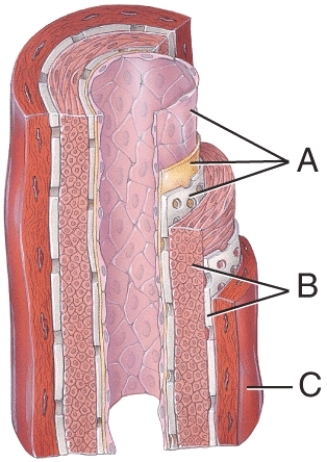A) reabsorption.
B) filtration.
C) bulk flow.
D) hydrostatic pressure.
E) colloid pressure.
Correct Answer

verified
Correct Answer
verified
Multiple Choice
The alternate route of blood flow to a body part through an anastomosis is called
A) anastome.
B) blood reservoir.
C) detour blood.
D) collateral circulation.
E) microcirculation.
Correct Answer

verified
Correct Answer
verified
Multiple Choice
Which layer consists mainly of elastic fibers and smooth muscle fibers that extend circularly around the lumen? 
A) A
B) B
C) C
D) A and B
E) A, B, and C
Correct Answer

verified
Correct Answer
verified
Multiple Choice
Which of the following hormones would NOT cause an increase in blood pressure?
A) atrial natriuretic peptide
B) antidiuretic hormone
C) aldosterone
D) angiotensin
E) increased norepinephrine
Correct Answer

verified
Correct Answer
verified
Multiple Choice
What does this figure represent? 
A) venous blood blockage
B) skeletal muscle pump
C) systolic blood pressure
D) capillary bed thoroughfare channels
E) velocity of blood flow
Correct Answer

verified
Correct Answer
verified
Multiple Choice
Which vessel plays a key role in regulating blood flow into capillaries?
A) arteries
B) arterioles
C) venules
D) veins
E) aorta
Correct Answer

verified
Correct Answer
verified
Multiple Choice
Which of the following vessels supplies blood to the intestines?
A) radial artery
B) subclavian artery
C) mesenteric artery
D) coronary artery
E) popliteal artery
Correct Answer

verified
Correct Answer
verified
Multiple Choice
The largest factor that promotes reabsorption of fluids, into blood, from the interstitial fluids is
A) tissue hydrostatic pressure.
B) tissue osmotic pressure.
C) blood colloid osmotic pressure.
D) blood hydrostatic pressure.
E) colloid pressure.
Correct Answer

verified
Correct Answer
verified
Multiple Choice
Which of the following would be the response of the body to decreased frequency of action potentials arising from the baroreceptors?
A) increased blood pressure
B) increased parasympathetic stimulation
C) decreased heart rate
D) decreased stroke volume
E) decreased cardiac output
Correct Answer

verified
Correct Answer
verified
Multiple Choice
Which of the following depends mostly on the ratio of RBC to plasma volume?
A) total blood volume
B) blood viscosity
C) systemic resistance
D) blood vessel length
E) size of vessel lumen
Correct Answer

verified
Correct Answer
verified
Multiple Choice
Which of the following vessels drains blood from the lower leg?
A) jugular vein
B) superior vena cava
C) tibial vein
D) coronary vein
E) iliac vein
Correct Answer

verified
Correct Answer
verified
Multiple Choice
Blood flow depends on which of the following criteria?
A) blood pressure
B) systemic vascular resistance
C) blood type
D) blood pressure and systemic vascular resistance
E) blood pressure and heart rate
Correct Answer

verified
Correct Answer
verified
Multiple Choice
Which of the following vessels supplies blood to the kidney?
A) hepatic artery
B) renal artery
C) mesenteric artery
D) coronary artery
E) popliteal artery
Correct Answer

verified
Correct Answer
verified
Essay
Describe the route of an RBC traveling from the heart to the left elbow and back to the heart.
Correct Answer

verified
From the heart, the RBC will enter the a...View Answer
Show Answer
Correct Answer
verified
View Answer
Multiple Choice
Where is the cardiovascular center located?
A) in the thorax
B) in the cerebral cortex
C) in the cerebellum
D) in the medulla oblongata
E) in the hypothalamus
Correct Answer

verified
Correct Answer
verified
Multiple Choice
What do the following have in common: superficial temporal artery, brachial artery, and dorsal artery of the foot?
A) They are all areas where you cannot hear Korotkoff sounds.
B) They are all only found on the left side of the body.
C) They are all pulse points.
D) None of them contain baroreceptors.
E) All of them are connected to each other by capillary beds.
Correct Answer

verified
Correct Answer
verified
Multiple Choice
Which of the following is the most important capillary exchange method?
A) diffusion
B) transcytosis
C) bulk flow
D) active transport
E) primary transport
Correct Answer

verified
Correct Answer
verified
Multiple Choice
Which of the following factors do NOT increase systemic vascular resistance?
A) decreased vessel lumen diameter
B) increased blood viscosity
C) decreased vessel length
D) increased vasoconstriction
E) increased blood cell count
Correct Answer

verified
Correct Answer
verified
Multiple Choice
All the veins of the systemic circulation drain into the
A) superior vena cava.
B) inferior vena cava.
C) coronary sinus.
D) superior and inferior vena cava.
E) superior and inferior vena cava and coronary sinus.
Correct Answer

verified
Correct Answer
verified
Multiple Choice
Elastic arteries function as a
A) vasodilator.
B) conduit to the tissues of the trunk only.
C) barrier to microcirculation.
D) pressure reservoir.
E) vasoconstrictor only.
Correct Answer

verified
Correct Answer
verified
Showing 21 - 40 of 45
Related Exams